Basics of Design
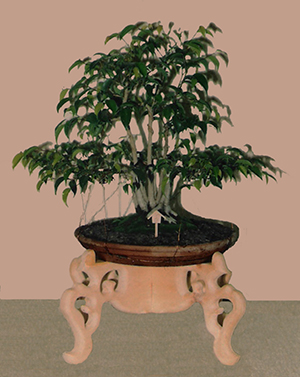
Clump
by Lew Buller
The members of the bonsai club liked bonsai with heavy trunks, often cutting the tops off larger trees to get a large trunk. I got the bright idea of planting a number of young trees close together, letting them approach graft one another, and creating a large trunk.
An added benefit was that I could bend the tops over and create branches at any height I wanted. “Clump” is the locally preferred term. When I got a copy of Naka’s Bonsai Techniques I, he called it “Sprout” style and illustrated several variations.
Ficus cuttings were easily available, so I stuck a handful of them together in a growing pot. Later, roots were trimmed and they went into a flat clay pot. I showed it at the club show on the beginners’ table.
Ficus grow fine in the ground in San Diego area, even where there are frosts. In pots, it’s a different matter. One cold night, unprotected, mine died. Even setting them under the eaves where the air flow is reduced might have saved them. I still like and use ficus as you will discover in the Know Your Tree Series.
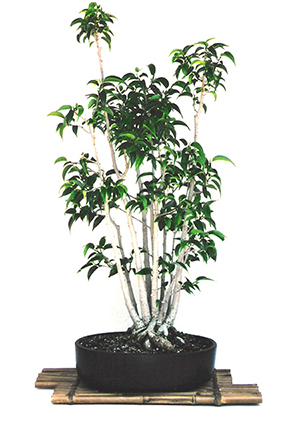
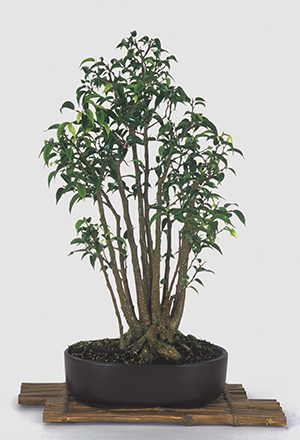
(l to r) July 20, 1998; July, 1999
The oldest photo of the clump that I can find is 1998. The clump came home with me from a nursery earlier. Although the clump had doubled in height Little Lucy ficus grow very slowly, taking at least 4 if not 5 years to double. A year later it was trimmed and you can see the beginnings of a clump. I’m going to show the development by showing the changes in the root ball rather than by changes in the foliage, with a full-length photo now and then, one of them 16 years later.
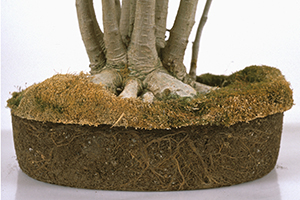
Dry root ball
Ficus benjamina can withstand torrential monsoon rains and hot dry spells after the rain. There was no lack of water in my back yard, but the roots appear as if they had suffered the dry spell following the rain. The reason? Moss kept the water from penetrating the soil and the roots dried out. I no longer keep moss on the soil around my trees, saving it for shows and photos. The clump stayed in that same pot until May2002, nearly 4 years. Then it went into a shallower pot. Grown up and dressed up, it appeared in my book, Saikei and Art. You may notice two more trunks, as I added 2 small ficus at the time of transplanting to the larger pot.
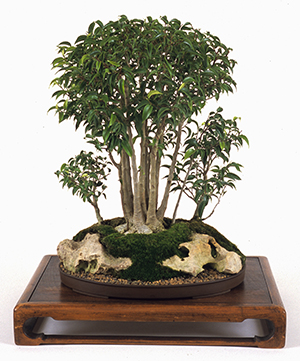
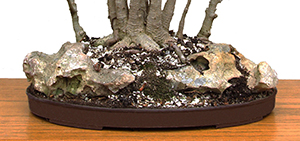
It couldn’t stay in that pot forever. Keeping bonsai slightly root bound, not transplanting so frequently, and trimming the minimum amount possible from the roots at transplanting helps to keep the trees small. How often you transplant depends on the species of tree, how carefully you monitor the tree, and size you want the tree to become. This appears to conflict with the material on transplanting but it does not; it is just an advanced concept for transplanting.
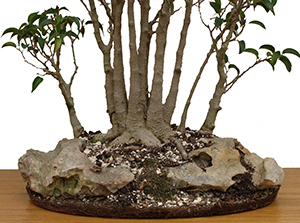
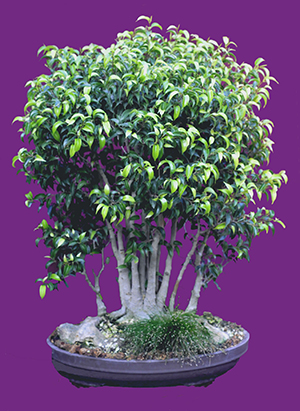
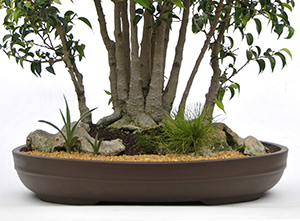
(l to r) May 2007; August 2008; May 2009
One of the purposes of transplanting is to get the tree ready for a bonsai pot. When you see the root ball that came out of this pot, you can see that it is ready for another bonsai pot. The root ball was trimmed only slightly on the bottom and on the sides and went into a larger pot.
It grew very well in the larger pot. In 15 months, the top had filled out, the small trunks had taken, and the clump was ready for a haircut. It was also time to pay attention to the elements that help make a saikei. Trees I had, stones I had, but vegetation and a representation of water were poor.
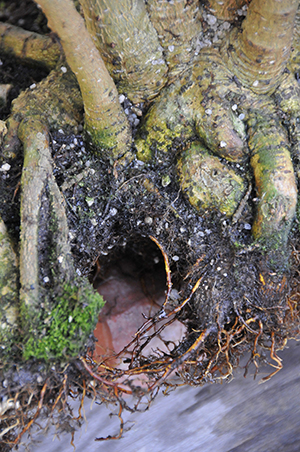
March 2011
Fixing those things gave a beautiful landscape for the composition in a photo dated May 2, 2009. Not everything, however, was sweetness and light for the clump. In March of 2011, the small tree on the right side died. There was no soil under the tree; it must have washed out over the years of watering. I put fresh soil in the open space, inserted another tree about the same size, and watered as usual. It lived. You can see it in the next photo.
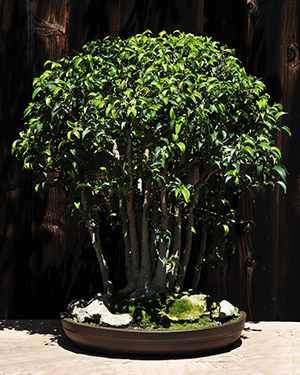
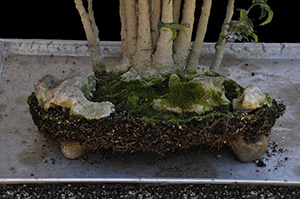
May, 2011
2010, 2011, and 2012 brought some health problems and not enough time for bonsai. This past year and a half, I have been playing catch-up with my bonsai. That includes the clump. It was transplanted in May 2013 but no effort was made to keep the moss and accessory plants. The roots had grown into and around the rocks so the root ball was transplanted as one single mass.
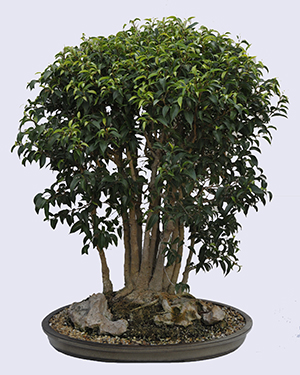
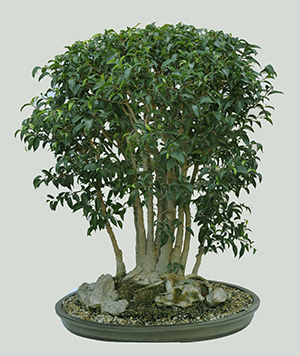
(l to r) July 4, 2014; July 6, 2014
It’s July 4, 2014, there are new leaves on the clump, the small new tree on the right is still alive. and its time to pay attention to the underlying structure. The trees have grown tall and leggy and the foliage needs to be brought down.
The top 2 ½” of recent growth was cut off. As new growth occurs, the same amount will be cut off. For you to see the difference, I really should have taken the photos from the top, looking down. The trimmed tree would appear much thinner as I reached down into the branch structure and cut larger old woody branches off. Inward pointing branches were removed, heavy sections were lightened up, and one of the main trunks was brought forward to allow sunshine to reach the lower parts of the other trunks and stimulate new growth.
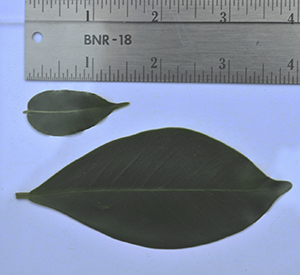
If you wonder why I like the Little Lucy ficus so much, take a look at this photo comparing the small ficus leaf to that of a ficus retusa, which by no means has the largest leaf in the ficus family.
Only one of the sprout styles in Naka’s Bonsai Techniques I has been shown here. John was a gifted illustrator, painter, photographer, and bonsai artist. He borrowed $30,000 against his home to self-publish this book and it was so successful that it provided an annuity to him and his family.
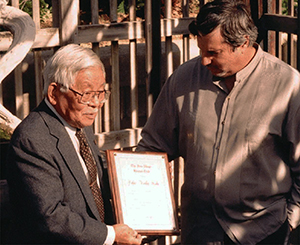
John was gregarious and impish and loved being center stage. Involved in many different activities, he taught bonsai in San Diego and was part of the effort to create the Bonsai Pavilion at San Diego’s Wild Animal Park. Many years after it opened, he visited the Park to see the Pavilion. Park officials declared it was John Naka day and put up a banner welcoming him. My arborist friend, Steve Valentine, was Curator of the Pavilion and I was Assistant Curator there.
I visited John at his home in Whittier, CA a number of times, once to take him a tree from the Park he had promised to wire and another time to pick it up.
The editor of this material may choose not to publish this paragraph. The last time I visited John, he had fallen and hurt his right arm. I found him in his garage, painting a tiger with his left arm. He asked me “You know what the worst thing about this is? I can’t wipe my behind.” The problem was solved with an elaborate commode that had wash-and-dry features, the latter including warm air.
John received honors from all over the world for his contributions to bonsai. Among them was a medal from the Japanese government. John’s influence will continue to be felt for many years by people who don’t know his name. His introduction of the Japanese style of bonsai to the West made a permanent change in the bonsai world.
